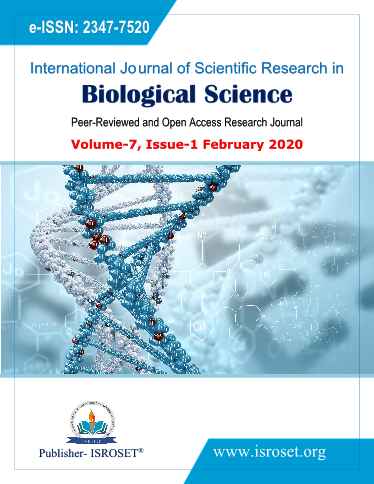Incidence of COVID-19 and Its Correlation between Temperature and Population Density
Keywords:
Corona Incidence, Temperature, Humidity, Population DensityAbstract
Meteorological parameters are the important factors influencing the infectious diseases such as SARS and influenza. A study of the prevalence of COVID-19 for each country as a function of temperature was used to define significant differences in temperature and relative humidity. The number of deaths caused by COVID-19, the meteorological parameters and geographical region data were collected from 28th March 2020 to 7th April 2020 worldwide. The correlation of population, population density, and temperature in cities where COVID-19 outbreaks are already becoming epidemics was studied. Generalized additive model was applied to explore the effect of temperature, humidity and population density with the number of cases confirmed, recovered and number of deaths of COVID-19. Worldwide, there were 7,52,394 confirmed, 5,23,480 actives, 1,50,732 recovered and 36,196 death cases due to COVID-19 confirmed. In the duration of case study, the range of the temperature was varied from -7°C to 37 °C. In Mongolia, where temperature range was about -6°C to 1°C, 14 cases were confirmed from the 32,78,290 population and in Burkina Faso, where temperature range was 27 °C to 37 °C, 214 cases were confirmed from the 2,09,03,273 population. USA, a very large area, has different temperature range in different states. For example, in Gaum, USA, there were 56 confirmed cases found in spite of the average temperature of 29°C and humidity 72%, whereas in Alaska, USA, with average temperature of -3°C and humidity 28%, there were found 102 confirmed cases. In summary, this study suggests that the temperature variation and humidity may not be the important factors affecting the COVID-19 mortality.
References
Qun Li, Xuhua Guan, Wu P, et al.,“Early Transmission Dynamics in Wuhan, China, of Novel Coronavirus-Infected Pneumonia,”The New England journal of medicine, 2020January 29.doi: 10.1056/NEJMoa2001316
Phelan AL, Katz R,Gostin LO. “The Novel Coronavirus Originating in Wuhan, China: Challenges for Global Health Governance,”Jama, Vol.323,pp.709-710, 2020 January 30. doi: 10.1001/jama.2020.1097
Wu F, Zhao S, Yu B, Chen YM, Wang W, Song ZG, Hu Y, Tao ZW, Tian JH, Pei YY, Yuan ML, Zhang YL, Dai FH, Liu Y, Wang QM, Zheng JJ, Xu L, Holmes EC, Zhang YZ, “A new coronavirus associated with human respiratory disease in China,” Nature,Vol.579, Issue.7798, pp.265-269, 2020 March. doi: 10.1038/s41586-020-2008-3
Zhou P, Yang XL, Wang XG, Hu B, Zhang L, Zhang W, Si HR, Zhu Y, Li B, Huang CL, Chen HD, Chen J, Luo Y, Guo H, Jiang RD, Liu MQ, Chen Y, Shen XR, Wang X, Zheng XS, Zhao K, Chen QJ, Deng F, Liu LL, Yan B, Zhan FX, Wang YY, Xiao GF, Shi ZL, “A pneumonia outbreak associated with a new coronavirus of probable bat origin,” Nature,Vol.579, Issue.7798, pp.270-273, 2020 March. doi: 10.1038/s41586-020-2012-7
Ewen Callaway,“Time to use the p-word? Coronavirus enters dangerous new phase,”Nature,2020February. doi 10.1038/d41586-020-00551-1
HEMMES JH, WINKLER KC, KOOL SM, “Virus survival as a seasonal factor in influenza and poliomyelitis,”Nature,Vol.188, pp.430-431,1960October 29.
Benjamin D. Dalziel, Stephen Kissler, Julia R. Gog, Cecile Viboud, Ottar N. Bjørnstad, C. Jessica E. Metcalf, Bryan T. Grenfell, “Urbanization and humidity shape the intensity of influenza epidemics in U.S. cities,”Science, Vol.362, Issue.6410, pp.75-79, 2018. doi: 10.1126/science.aat6030
Abdulrahman Isah Hazo, John Alemaka, Khadija Atiku, Aliyu Bello Musa, “Analysis of Trends and Variability in Air Temperature as Evidence of Climate Change in Zaria, Kaduna State,Nigeria”, International Journal of Scientific Research in Multidisciplinary Studies,Vol.6, Issue.1, pp.01-11, 2020 January.
Peder Wolkoff, “Indoor air humidity, air quality, and health – An overview,” International Journal of Hygiene and Environmental Health, Vol.221, Issue.3, pp.376-390, 2018.doi.org/10.1016/j.ijheh.2018.01.015
Downloads
Published
How to Cite
Issue
Section
License

This work is licensed under a Creative Commons Attribution 4.0 International License.
Authors contributing to this journal agree to publish their articles under the Creative Commons Attribution 4.0 International License, allowing third parties to share their work (copy, distribute, transmit) and to adapt it, under the condition that the authors are given credit and that in the event of reuse or distribution, the terms of this license are made clear.







